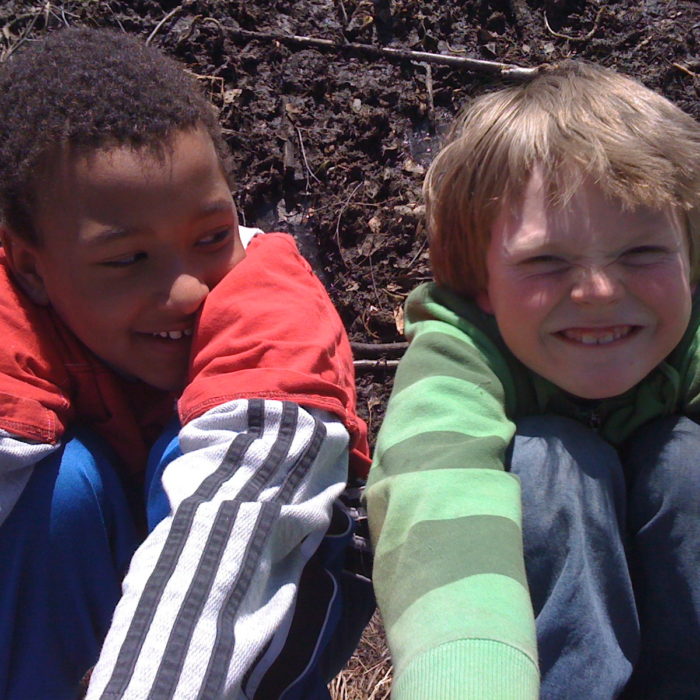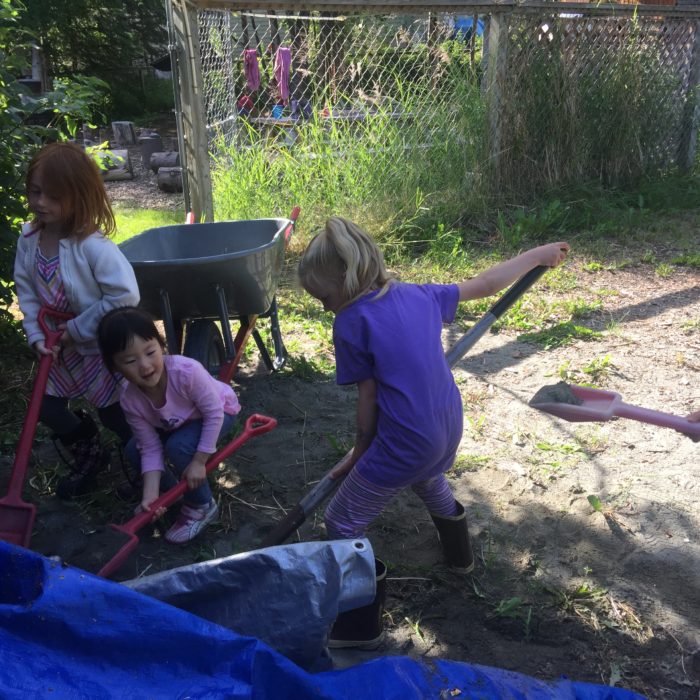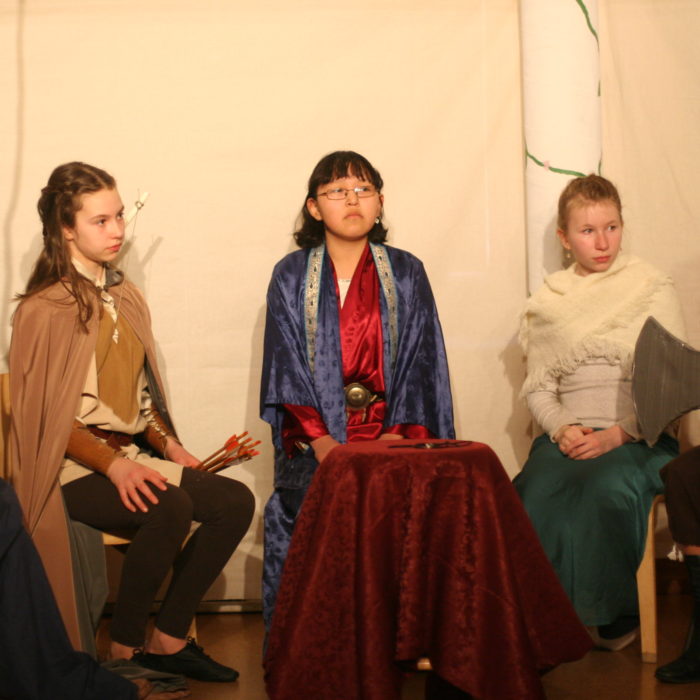Overview
Our school recognizes that children pass through distinct stages of development thereby believing that both the subject matter and the method of teaching need to be age specific. We use and refer to the Waldorf curriculum as the primary inspiration of instruction at our school. What sets the Waldorf curriculum apart is not necessarily what is taught but how it is taught. The teachers at the Anchorage Waldorf School carefully balance academic, artistic and practical activities to stimulate the imagination and prepare students as thoroughly as possible for life experiences. Instead of passively receiving information, our students are involved in a dynamic process of exploration, both of the world and of themselves. When you tour our classrooms you will be inspired by the bright, thriving students who have an inner enthusiasm for learning – essential to educational and personal success.
The class teacher: In the elementary school years, the class teacher ideally advances with the students from first through eighth grade, overseeing each child’s educational journey. Our class teachers bring extensive life experience and specialized training in the methods and philosophy of Waldorf pedagogy. This continuity allows the teacher to know the students’ unique qualities in order to plan lessons that reach and motivate each child. The relationship between teacher and child is constantly evolving and deepening.
Main Lesson: The day begins with a two-hour period called main lesson, which is devoted to the in-depth study of a specific academic subject, each lasting three to four weeks. Over the course of eight years, the children at the Anchorage Waldorf School have covered more skills and topics than a conventional elementary school curriculum and have done so in a meaningful, experiential and age-appropriate way.
Foreign Languages: We offer Russian throughout all the grades at the Anchorage Waldorf School. Initially, through story, song, rhyme and movement, students become acquainted with the qualities of different cultures. As students progress through the grades, they develop skills in grammar, reading and translation.
Arts: Drama, painting, drawing, modeling, woodworking and movement deepen the students’ experience of the curriculum and awaken possibilities for self-awareness and self-expression. Each class presents a dramatic performance each year in addition to regular opportunities to share their abilities at school assemblies and holiday programs.
Music: Music permeates every child’s school experience each day through singing, learning musical notation, performances and instruction on multiple musical instruments that all children receive.
Movement Education: The movement education program begins in the lower grades with games and activities that spark their imagination and provide enjoyment of physical activity in a non-competitive environment. In the upper grades, students become skilled in a variety of sporting activities.
Handwork: Through handwork, children learn the value of creating practical and beautiful objects with their own hands. All children are provided with the opportunity to learn to knit, crochet, wood craft, cross-stitch and sew.
Festivals: The celebration of festivals is a meaningful way for the children and school community to attune themselves to the rhythms of the year. The festivals are celebrated through stories, songs, performances and community get-togethers.
Our Curriculum at Anchorage Waldorf School (AWS) in Comparison to the Anchorage School District (ASD), Grades 1-8:
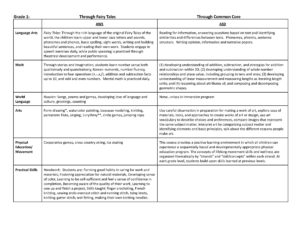
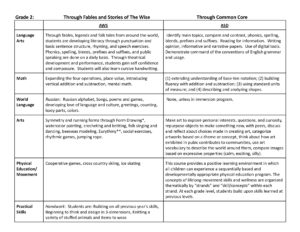
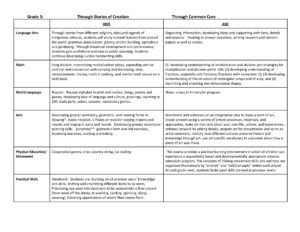
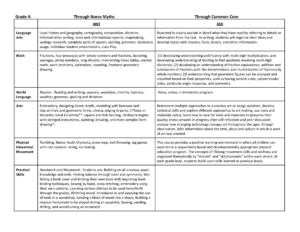
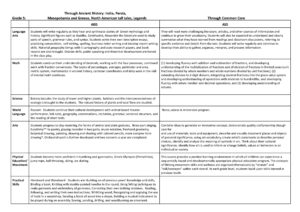
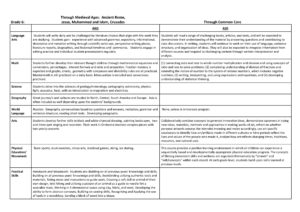
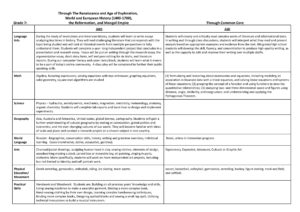
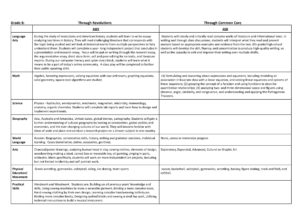
Preschool and Kindergarten
“If you want your children to be brilliant, tell them fairy tales. And if you want them to be even more brilliant, tell them more fairy tales.” -Albert Einstein
3 to 6 year-olds
(3-day and 5-day classes, Preschool, Kindergarten and extended-day programs available)
The Early Childhood Education program at the Anchorage Waldorf School is based on the understanding that young children learn primarily through imitation. Storytelling, puppetry and creative play kindle the imagination and form the basis of numeracy and literacy. Problem solving and logic are developed through block building and active outdoor play. Outdoor play and nature walks increase physical strength, agility and grace, fostering a meaningful connection with the natural world and laying the groundwork for future scientific studies.
Fine motor skills are cultivated through painting, drawing and beeswax modeling. Social harmony is fostered with circle games, singing, handwork and practical activities. Seasonal festivals create a rhythmic schedule and foster a heartfelt relationship with nature. The sharing of practical activities such as snack preparations, clean-up, and plant care starts the child on the path toward personal responsibility and respect for others.
The day’s activities unfold in an unhurried way with each day following an established rhythm, giving the child a sense of security and consistency. It is an environment of love, warmth and harmony that serves as a gentle transition between the security of home and the coming grade years. The child’s days are filled with both structured and unstructured activities that exercise their fresh and dynamic powers of imagination. To begin formal academic study at this time is to rush the child through that period of life when their proper work and most effective way of leaning is through imaginative play.
Golden Cottage Childcare – Before care starts at 7:30 am and Aftercare is available to 6 pm for ages five and up.
First Grade
Emphasis on the arts using natural materials (water colors, beeswax modeling, coloring); fairy tales and nature stories; singing; pictorial and phonetic introduction to letters; form drawing; reading approached through letters; qualities of numbers; introduction to the four processes in arithmetic. Part of each week is devoted to learning a foreign language, to handwork, and to playing the pentatonic recorder.
Second Grade
English now becomes a special subject assigned its share of main lesson periods. Based again on the spoken languages, fables satisfy the children’s deep interest in the animal kingdom while legends offer lofty striving and highlight the noblest human qualities. These fables and legends now become the focus of writing material. The curriculum will also include reading, cursive writing, arithmetic, elements of grammar, languages, music, singing and handwork.
Third Grade
Quickened physical growth takes place during this transition period in which the age of dream is passing and a new age is beginning to dawn. Now there is a shifting emphasis as the child’s relation to the world around him changes: to the extent to which the child feels separate from the world he seeks knowledge of it and his studies will now have a more realistic, practical character. The curriculum will include history, reading, spelling, original composition, grammar, punctuation and parts of speech, cursive writing, arithmetic, multiplication tables, weight, measure and money, languages, handwork, and music.
Fourth Grade
The fourth grade marks an important transition from the focus on foundation building in the lower grades to the expanding study of content in the upper grades. The nine/ten year old is meeting the world with a new self-consciousness and an enthusiasm for learning more of the intricacies of the world in which they live. Through the fourth grade curriculum they will make a soul connection with the characters of Norse mythologies who struggled to create a new world out of chaos and they will develop a respect and appreciation for the early settlers of Alaska through their study of local geography and history.
Man and Animal will be their first science block and marks a transition from the nature stories and fables of earlier years to the experimental science they will encounter later. The study of fractions at this time is ideal as well for it directly mirrors the separation of the world into its parts as the child now views the world. Complementing the study of history is the study of tenses in grammar for now the child can comprehend more clearly the differences between past, present, and future. Writing and composition and foreign language are expanded. The children continue their artistic development through handwork, music, drawing, painting, form drawing, and violin.
Fifth Grade
The fifth grader has grown more accustomed to seeing the world as a unique individual. The fifth grade curriculum works with this deepening awareness, and builds on the already established foundations as it introduces new elements to prepare the student for the next steps forward. History moves from its pictorial and personal nature, as presented in the earlier grades, to being a special main lesson subject along with geography. History, telling of mankind’s deeds and strivings, stirs the child to a more intense experience of his/her own humanity. The children journey to ancient India where human beings were dreamers, through ancient Persia where the impulse was to transform the earth, till the soil and domesticate animals while helping the sun-god conquer the spirit of darkness. Going on through Mesopotamia and the Egyptian civilization, the fifth grader comes to the unique Greek culture where all matter was imbued with spirit. This is considered the end of ancient history.
History at this stage of the curriculum is an education of the children’s feelings rather than of their memory for facts and figures. History brings the child to an awareness of those events in time up to and including his/her own time. In this way, it brings the child to himself. Geography, on the other hand, brings the child into the world. American geography emphasizes contrast. The earth’s physical features are linked with a study of the way people lived in the regions, the uses made of natural resources, and the industry that arose.
As a continuation of their study of the living earth, fifth graders take up botany, the study of the plant world, first in their own environment, then attending to vegetation in other parts of the world. Form drawing expands into freehand geometry. Arithmetic expands from fractions to decimals. Singing in unison and harmony is practiced while continuing music study with the flute and the violin. Woodworking is a new experience for the fifth grader while handwork returns to knitting in a more complex way. Foreign languages, painting, eurythmy and movement classes continue.
Another special Waldorf experience for fifth graders is hosting or participating in a Greek Pentathlon where grace, beauty, form and sportsmanship are lauded along with individual achievements of speed or accuracy.
Sixth Grade
The sixth grade is a firm step into the outer world. As children approach eleven or twelve, changes begin in their physical bodies. One of the most subtle is a hardening of the bones. Boys and girls are more aware of gravity and weight. With an increasing awareness of their physical bodies, the time is right for the study of the physical body of the earth. Mineralogy takes the children into a study of the rock formations of the earth, forces that change the shape of the earth’s surface, and the examination and study of three types of rocks, minerals, and precious metals and gems. As the world continues to expand for sixth graders, the distribution of oceans, seas, continents, and mountain masses, along with climate studies come into their study of geography. The geography of Europe will be compared and contrasted with the geography of North America. An introductory acquaintance to astronomy takes the student into the relationship of the earth to other bodies of the solar system.
Sixth grade students are introduced to the basic concepts of physics. Coming through the arts, music takes them to acoustics and color takes them to optics. Heat, electricity, and magnetism are other topics of study in physics.
Sixth grade history follows the transition from ancient to modern history. Moving from the decline of Greece, through the rise and fall of Rome, and into life in the Middle Ages, the students begin to grasp history as a temporal sequence of cause and effect relationships. The Roman spirit matches the child’s feeling of omnipotence, yet equally important for the children is the example of the effects of the excesses of the Roman period.
The disciplines of mathematics learned earlier are kept active in the children and they move on to study percentages, ratios, and business math. Geometry studied in the sixth grade brings all their previous free hand and body movements used for circle and form drawing into exact constructions, using compass, rulers, and right angles. Families of geometric figures are constructed and studied for the numerical laws they embody.
Shadows, landscapes, and color contrasts are taken up in painting. Handwork relates to form and structure as the children design and create a gusseted stuffed animal. They continue to develop their skills with tools in wood carving, creating objects that serve the human or animal world. Singing focuses on two and three part choruses, songs of the minstrels and middle ages, and recorders in descant, alto and tenor voices.
Eurythmy expands to include simple tone eurythmy whereby students learn gestures which correspond to musical forms. Geometric forms and transformations also bring challenge to the students in Eurythmy.
English continues with more emphasis on reading, writing, and grammar and foreign language continues with reading of simple texts, humorous stories and free translation. Sixth grade is the gateway to preadolescence and idealism. They become more grounded as to who they are and begin to look out into the world to see what it asks of them.
Seventh Grade
Seventh graders come to school with a spirit of inquiry and creativity, seeking to discover the larger world and push the limits of their understanding. We have designed the seventh grade curriculum with this in mind. It meets the need to question traditional authority by challenging their blossoming individualism and the developmentally appropriate stage of testing boundaries.
Seventh grade students are actively engaged in the sciences of Physics, Chemistry, and Physiology. Beginning with the lever principle, Physics lessons present mechanical concepts to students. Inorganic Chemistry lessons bring a study of the combustion process externally and in the human organism as digestion, and physiology introduces the study of other life processes such as circulation and respiration.
Other areas of the curriculum also continue to expand and enrich the students’ experiences. Mathematics lessons introduce Algebra which brings the child’s imaginative powers strongly into use. Perspective Drawing brings geometry into complex forms. English blocks involve creative writing, literature and young authors learn that a variety of styles can be used to accurately specify feelings. Music, Eurythmy, Drama, Handwork, Woodwork, and Clay Modeling continue to be a regular part of the students’ curriculum.
Eighth Grade
8th Grade stands as the culmination of elementary school bringing all previous experiences to a new peak, enabling the students to enter high school with inner confidence and academic readiness.
History meets the students’ longing for change by investigating the modern world beginning with the Age of Revolutions up to present times. All the literature read introduces the theme of coming of age and the freedom that accompanies this passage. Geography, Ecology and Meteorology focus on the role played by the Earth’s structure and innate forces in every part of contemporary society. The disciplines of science further this inquiry through experiments and observations. Chemistry and Physics demonstrate natural laws at work around them. Then, Physiology and Anatomy demonstrate the incredible doings of the human body. Mathematics remains a present part of their studies emphasizing the practical applications of arithmetic, algebra, and geometry.
Foreign Languages
Russian is an integral part of the curriculum in all grades at the Anchorage Waldorf School. Initially taught through story, song, rhyme and movement, students become acquainted with the qualities of different cultures. As students progress through the grades, they develop skills in grammar, reading and translation.
Music
Music is an integral part of the curriculum. First and second graders concentrate on singing, playing the pentatonic flute and practicing general music skills such as careful listening, pitch-matching and rhythmic clapping. The diatonic recorder is introduced in third grade, along with music notation and singing in rounds. In grades four through eight, violin is added to the curriculum. In violin class they learn to play the violin and have their first experience establishing a practice routine at home. In general music class, the fourth and fifth graders learn to sing rounds and two-part songs, play recorder music in parts and study music notation and sight-reading. Starting in fifth grade, some students choose to play viola or cello, or delve deeper into ensemble recorder playing.
Handwork and Woodwork
Through handwork, children learn the value of creating practical and beautiful objects with their own hands. All children are provided with the opportunity to learn to knit, crochet, cross-stitch and sew.
See also this article on Knitting and Intellectual Development.
Movement and Games
Goals of the Movement and Games Program at the Anchorage Waldorf School
–To prepare the child for kind deeds by developing the ability to work and play with (and as) a group.
–To prepare the child for brave deeds by developing a sense of growing strength, flexibility and stamina.
–To prepare the child for responsible deeds by developing the ability to listen and follow directions.
–To prepare the child for graceful, joyful deeds and balance in movement and life through circus arts, tumbling and Bothmer Gymnastics.
–To develop an understanding and a healthy approach to movement and exercise, as well as specific skills in relationship to sport and games.
What is Eurythmy?
Eurythmy is an art, in which the human body recreates in space the sounds of speech and the tones and intervals of music.
Through doing Eurythmy children develop powers of imagination, concentration and presence of mind. The children learn to recognize what part they as individuals have to play in a social group. Interaction between the outer world and their own inner life is brought into harmony through doing rhythmical exercises.
For the young child in Class One the fairytale can be brought into their life of movement. The darting fish in the tale is the same image as the eurythmy sound ‘f’, so is the sound and movement ‘B’ for the big brown bear. Music is also a part of the lesson, the children walk and run forms in space, and step different qualities of rhythms: i.e. the light Anapaest for the prince’s horse galloping through the forest, or the Spondee for the giant walking heavily home from his hard day’s work.
As the children grow older more complicated movements are introduced and this culminates in items of music and poetry being performed in the higher classes.
Thanks to Raphael House Rudolf Steiner School for this apt description!
We offer our children the opportunity to interface with nature from a very early age through recess, outdoor play, bog walks, gardening, class wilderness trips, and a new formalized program using traditional skills for outdoor survival.
Waldorf education, through AWSNA, was recognized by the Captain Planet Foundation as the recipient of this year’s Green School Award for “…demonstrating extraordinary environmental stewardship, helping to protect and preserve the natural balance and beauty of our land and actively putting forth a significant effort in making the world a better place.”
Here are some examples from the outdoor education program and classroom curriculum at Anchorage Waldorf School:
–Nearby Baxter Bog serves as an outdoor classroom for walks, science study, play, and exploration for students of all ages. In turn, we serve as stewards of the Bog by clearing and maintaining trails. Students created and illustrated educational panels that are mounted throughout the bog with information for visitors about the habitat and the animals who dwell there.
–A core unit of the third grade curriculum is Practical Life Studies: farming, house-building, gardening and composting. Highlights from this year’s study include an overnight trip to a homestead near Talkeetna where the children took a nature walk, picked berries, harvested vegetables, packaged seeds, cleared beds for the winter, and gathered rocks to build a fire pit. They also visited a local garden center in Anchorage and they are designing and building their own garden on campus.
–Much of our Movement Education program for students in grades 1-8 takes place outdoors with activities including cross country running, cross-country skiing, orienteering, and snowshoeing. We use the space on our 2.5 acre campus and also regularly travel to nearby Baxter Bog, Goose Lake, and Russian Jack Park.
–Anchorage Waldorf School has connected with the trained professionals of 4 Elements Earth Education (Rick Berry) and Merlin Outfitters (Klaus and Laura Lerch) to provide a program of earth-based education, outdoor wilderness activities, and experiential skill practice for outdoor survival, tracking and awareness. Drawing on indigenous teaching techniques, this curriculum subtly engages students in a spontaneous flow of interactive learning opportunities with the goal of: strengthening powers of concentration, observation and endurance; providing access to deep reservoirs of self-confidence and self-knowing; cultivating intimate, respectful relationships between students, the Earth, and all who dwell upon her; empowering, inspiring and preparing students to become active, responsible caretakers of the Earth.
In September, our sixth, seventh and eighth graders traveled to Trapper Creek for a 3-day, 2-night experience led by Klaus, Laura and Rick. Focusing on the four survival elements of shelter, water, fire and food, students established a camp, crafted their own bow drill sets for fire making, built shelters, wove cordage, and cooked meals over coals. They also developed tracking and awareness skills through activities in the woods and paths surrounding the camp. Our third, fourth and fifth graders spent a day with Rick, Laura and Klaus at Baxter Bog building a survival shelter and playing outdoor games.
“If a child has been able to play, to give up his whole, loving being to the world around him, he will be able in the serious tasks of later life to devote himself with power and confidence to the service of the world.” -Rudolf Steiner
Sessions for 2021 – 2022 School Year:
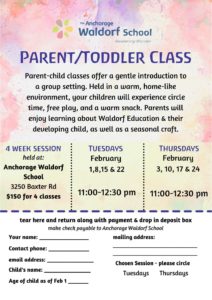
February 1-24
All classes are on Tuesdays or Thursdays from 11:00 am – 12:30 pm
Fee: $150 for 4-week course.
Our Parent and Child classes are for parents with children from birth to 3 1/2 years old. Led by an experienced Early Childhood teacher, the Parent and Child program is a nurturing, gentle transition from home life to school. While the children play and explore, parents will get a glimpse into the rhythm and philosophy of Waldorf Education through discussion, meaningful work, and artistic projects. Songs, movement, and a short puppet play complete a joyful morning together.
These sessions emphasize child observation and parent-child interaction in a supportive atmosphere that allows parents to learn about the Waldorf approach to early childhood while their children engage in creative play and artistic activities with the teacher, parents and each other.
To register your family, please call the school at 333-9062 or email enroll@waldorfak.org. Seasonal craft materials, snacks and literature on child development are included in the fee.




